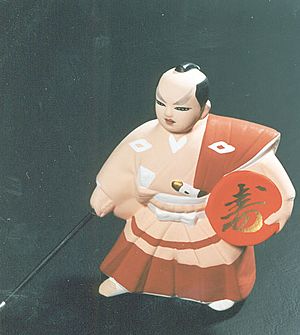Hakata doll facts for kids

A Hakata doll (博多人形 (Hakata ningyō)) is a special type of traditional Japanese clay doll. These beautiful dolls come from the city of Fukuoka, in Japan. A part of Fukuoka was once called Hakata before the city joined together in 1889. Hakata dolls are famous for their detailed designs and the way they capture different parts of Japanese culture.
Contents
What are Hakata Dolls?
Hakata dolls are handmade figures crafted from clay. They are known for their smooth, unglazed finish and vibrant painted details. Artists carefully shape the clay, fire it, and then paint each doll by hand. This makes every Hakata doll a unique piece of art. They often show people, animals, or scenes from daily life and history.
A Look Back: History of Hakata Dolls
The art of making Hakata dolls has a long and interesting history. It goes back many centuries in Japan.
Early Beginnings
The first Hakata dolls were made around the 17th century. Potters in the Hakata area started making clay figures. These early dolls were often simple and used for religious purposes or as toys. Over time, the artists began to add more detail and color.
Becoming Famous
Hakata dolls became very well-known during the Meiji period (1868-1912). This was a time when Japan opened up more to the world. Hakata dolls were shown at international exhibitions. People from other countries were amazed by their beauty and craftsmanship. This helped the dolls gain fame around the globe.
How are Hakata Dolls Made?
Making a Hakata doll is a careful process that takes many steps. It requires great skill and patience.
From Clay to Art
First, artists use a special type of clay. They mold the clay into the desired shape. Sometimes, they use molds for the basic form. Other times, they sculpt the entire doll by hand. After shaping, the clay doll is dried. Then, it is fired in a kiln at a high temperature. This makes the clay hard and strong.
The Finishing Touches
Once the doll is fired, it is ready for painting. This is where the doll truly comes to life. Artists use bright colors to paint the doll's features, clothing, and expressions. They add tiny details, like the patterns on a kimono or the strands of hair. Each brushstroke adds to the doll's unique character.
What Do Hakata Dolls Show?
Hakata dolls often show many different themes. They reflect Japanese culture, history, and daily life.
- Beautiful Women: Many dolls show elegant women in traditional kimonos. These often represent geisha or dancers.
- Samurai and Warriors: Strong samurai figures are also popular. They show brave warriors from Japan's past.
- Children: Dolls of happy children playing or celebrating are common. They often bring a sense of joy.
- Gods and Legends: Some dolls show figures from Japanese myths and legends. These can be very detailed and powerful.
- Everyday Life: You might also see dolls showing people doing everyday tasks. This could be a farmer, a fisherman, or a merchant.
Hakata Dolls Today
Today, Hakata dolls are still highly valued. They are seen as a symbol of traditional Japanese art. Many people buy them as souvenirs or gifts. They are also collected by art lovers around the world. You can find them in museums, art galleries, and special craft shops in Fukuoka. The artists continue to create new designs while keeping the old traditions alive.

